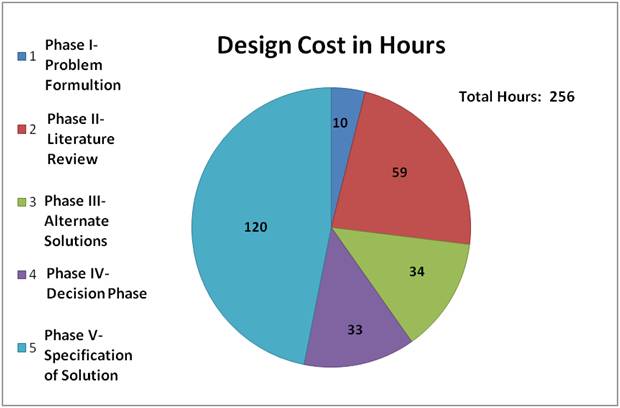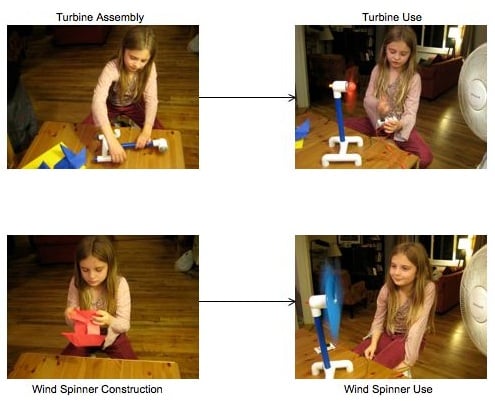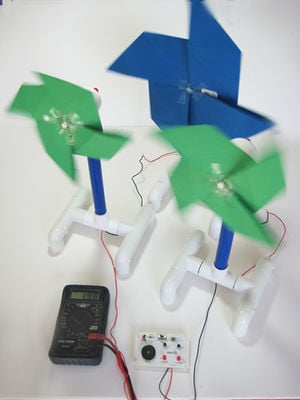
The lesson plan, The Power of Wind, provides the means of educating fourth-grade students on the topic of renewable wind energy. Enrolled in the Engineering 215 class at Cal Poly Humboldt, Team JTRM utilized the teachings of the class's instructor, Lonny Grafman, to design The Power of Wind. The Engr205 class provided a structured design process for Team JTRM to follow. The team also worked for their client, the Redwood Coast Energy Authority (RCEA). The team worked throughout the Spring Semester of 2010 to complete the design project. Team JTRM completed and tested The Power of Wind lesson. The lesson is available to teachers at the RCEA in Eureka, California.
Client Background[edit | edit source]
The RCEA is an organization working to develop programs within the community involving energy conservation and energy education.

Mission Statement:
"The Redwood Coast Energy Authority's purpose is to develop and implement sustainable energy initiatives that reduce energy demand, increase energy efficiency, and advance use of clean, efficient and renewable resources available in the region."
Criteria[edit | edit source]
Both Team JTRM and the client, worked to generate criteria for the design project. It was determined that the final solution to the design project had to meet all of the criteria. The criteria are weighted from 0-10, 0 being of least importance and 10 being of highest importance. Also shown in Table 1 is a description of every criterion.
Table 1: Criteria
| Criteria | Weight | Description |
|---|---|---|
| Safety | 10 | Safety is the ability to prevent injury of any kind. The lesson must not be unsafe for children in the fourth grade. |
| Effectiveness | 10 | The lesson effectiveness is the extent to which students retain the lessons given material. Students must retain information on wind power. |
| Cost | 5 | The cost of the project must be under 400 dollars. The total cost is to be divided by five, 100 dollars from the RCEA and 75 dollars from each group member. |
| Durability | 8 | Durability is the ability of the project to sustain a functional state in a fourth grade classroom and in storage. |
| Aesthetics | 7 | Aesthetics is the projects level of visual appeal. The completed lesson plan's contents must be visually appealing to the students. |
| Portability | 6 | The weight of the completed project must be an amount to which the teacher can easily maneuver the lesson box. |
| Maintainability | 6 | Maintainability of the project is defined as the total cost required to sustain the functionality of the project. The maintenance costs must be of a reasonable amount. |
Description of Final Design[edit | edit source]
The Power of Wind is a one hour lesson plan, shown in Figure 2, that is designed to educate fourth grade students on the basics of wind power. The students learn about the basics of wind, how wind turbines operate, and how wind power transfers electricity.
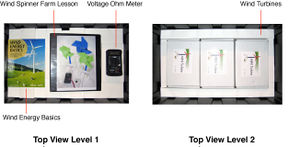
Figure 2: The Power of Wind
The Power of Wind lesson has four sections: a lecture introducing wind power, student assembly of a mini wind turbine, student construction of origami wind spinners, and a vocabulary worksheet.
Vocabulary Handout[edit | edit source]
The instructor begins the lesson by giving out a vocabulary sheet, as seen in Figure 3, on the basic components of a windturbine along with other vocabulary terms related to wind energy. The instructor will refer to the lesson binder which containins a power point and printed materials for the content of the lesson.
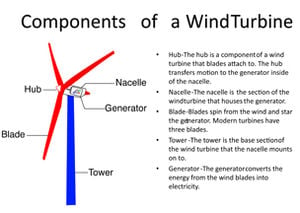
The instructor will also be supplied with the book Wind Energy Basics by Paul Gipe to provide additional supplementary information.
Wind Turbine Assembly[edit | edit source]
Following the vocabulary introduction students will then work in groups to assemble mini wind turbines. Groups will follow printed step by step instructions along with an instructional video, seen below, to complete the activity.
Wind Spinner Folding[edit | edit source]
Following turbine assembly, students construct their own origami turbine blades from construction paper. Students use printed step by step instructions along with an instructional video, seen below, to complete the activity. The students will experiment with their modified blades by observing rotational velocity and measuring the power transfer of the generator.
Wind Spinner Experiment[edit | edit source]
The instructor then connects three turbines in series modeling a wind farm as shown in Figure 4. The wind farm will be attached to a board that can flash lights or play music when the power supply is sufficient (1.2 volts).

Worksheets[edit | edit source]
Lastly, the students are provided a take home worksheet designed to enhance their vocabulary and to reinforce observations made in class. These vocabulary words are wind power related, and are defined by the instructor.
Costs[edit | edit source]
The cost of team JTRM's The Power of Wind lesson plan includes implementation costs, maintenance costs and designing costs in hours.
Implementation Costs[edit | edit source]
The implementation costs for this project can be seen in Table 2. This table is the costs TEAM JTRM spent to develop this lesson plan. The lesson plan has an overall cost of $240.21.
Table 2: Implementation Costs
| Materials | Cost |
|---|---|
| Wind Farm | $88.72 |
| Instructional Book | $23.76 |
| Two Boxes | $22.00 |
| Foam Box Inserts | $10.83 |
| Cardstock Paper | $7.00 |
| Clear Tape | $0.99 |
| Voltage Ohm Meter and Battey | $29.48 |
| Pentel Erasers | $4.30 |
| 1" View Binder | $5.44 |
| Sheet Protectors | $3.99 |
| Foam Board | $6.29 |
| 8-Tab Dividers | $4.39 |
| Elmers Glue | $2.14 |
| Box Size | $17.33 |
| Laminating Sheets | $7.96 |
| Three Clasp Envelopes | $4.99 |
| Total | $240.21 |
Maintenance Costs[edit | edit source]
JTRM has included a list of the costs to maintain The Power of Wind lesson. The maintanence costs can be seen in Table 3. Team JTRM is estimating the annual cost for the project to be used 15 times per year. The annual cost to maintain this projet is $151.95.
Table 3: Maintenance Costs
| Maintenance Costs | Costs Per Use | Annual Cost(15 times per year) |
|---|---|---|
| Worksheets | $3.00 | $45.00 |
| Cardstock Paper | $3.99 | $59.85 |
| Tape | $0.99 | $14.85 |
| Pentel Erasers | $2.15 | $32.25 |
| Total | $10.13 | $151.95 |
Costs in Time[edit | edit source]
Team JTRM has categorized the amount of hours involved in each section of this project, shown in Figure 5. The total time Team JTRM worked on this project was 256 hours.
Figure 5: Design Costs
Testing Results[edit | edit source]
Team JTRM tested the final design with one student named Sage. Sage successfully assembled a miniature wind turbine and constructed an origami wind spinner, shown in Figure 6. Sage also experimented by running the turbine while interchanging the plastic blades and the wind spinner. Using a voltage ohm meter and electric board, Sage made the inference that the plastic blades transferred more energy than the wind spinner did.
Team JTRM believes that the testing showed that The Power of Wind lesson met the project criteria. There were no safety or durability issues during the testing. Sage also had fun while experimenting with The Power of Wind.
Figure 6: Final Solution Testing


